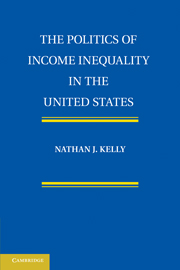Book contents
- Frontmatter
- Contents
- List of Figures
- List of Tables
- Acknowledgments
- 1 Explaining Income Inequality
- 2 The Distributional Force of Government
- 3 Political Conflict over “Who Gets What?”
- 4 Party Dynamics and Income Inequality
- 5 Macro Policy and Distributional Processes
- 6 Putting the Pieces Together: Who Gets What and How
- 7 Distribution, Redistribution, and the Future of American Politics
- Appendix A Congressional Questionnaire
- Appendix B Measuring Income Inequality over Time
- Bibliography
- Index
4 - Party Dynamics and Income Inequality
Published online by Cambridge University Press: 24 October 2009
- Frontmatter
- Contents
- List of Figures
- List of Tables
- Acknowledgments
- 1 Explaining Income Inequality
- 2 The Distributional Force of Government
- 3 Political Conflict over “Who Gets What?”
- 4 Party Dynamics and Income Inequality
- 5 Macro Policy and Distributional Processes
- 6 Putting the Pieces Together: Who Gets What and How
- 7 Distribution, Redistribution, and the Future of American Politics
- Appendix A Congressional Questionnaire
- Appendix B Measuring Income Inequality over Time
- Bibliography
- Index
Summary
This chapter marks a turning point in the story of equality and inequality in America. To this point, I have examined inequality and the politics of inequality through a cross-sectional lens. The degree of inequality, who has the money, what government does to influence inequality, and partisan and ideological differences regarding inequality have been examined using one snapshot frozen in time at the dawn of the twenty-first century. This chapter marks a change in perspective from the static to the dynamic. From this point forward, I will examine movement in income inequality over time and will utilize time series methods to accomplish this task. This change in perspective will provide the capability to examine not just what government does or does not do about inequality, but whether macro political change has influenced the path of income inequality in the United States. By shifting to a cross-temporal analytical perspective, I will assess whether political dynamics are connected to the dynamics of income inequality. For some readers, the simple promise of exploring the connection between politics and income inequality is likely to generate interest in this research. But analyzing the connection between political dynamics and income inequality also sheds light on existing theories and provides opportunities for developing new explanations about the connections between politics and economics.
A THEORY OF DISTRIBUTION AND REDISTRIBUTION IN THE UNITED STATES
My examination of the influence of political dynamics on distributional outcomes is rooted, first, in the macro politics model of American politics.
- Type
- Chapter
- Information
- The Politics of Income Inequality in the United States , pp. 79 - 117Publisher: Cambridge University PressPrint publication year: 2009



